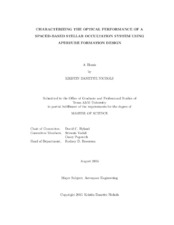| dc.description.abstract | Stellar occultation is a widely-used method to characterize space-faring objects such as near Earth asteroids, moons and minor planets that pass in front of distant stars. However, the conventional method is limited in that it assumes the occulting object is large enough, or close enough, to cast a sharp shadow. For instance, smaller asteroids that are still large enough to cause severe damage to the Earth upon impact create shadow patterns that are heavily diffracted, making identification and characterization of them difficult.
This thesis develops results supporting novel space-based stellar occultation systems which use shadow diffraction principles to resolve silhouettes of smaller near-Earth asteroids. A formation of light-gathering telescopes is positioned at a halo orbit about the Sun-Earth L2 libration point. The apertures are positioned in various configurations to better characterize system requirements. The dynamics and control of three candidate geometries are evaluated using the circular restricted three-body problem. Both Proportional Derivative and Linear Quadratic Regulator controls are implemented to maintain the formation geometry with negligible error and very low control forces. Additional parameters such as the size of the array, number of apertures, and overall formation geometry, are discussed to find relationships relating these parameters to the system’s optical performance. The most efficient formations are examined and compared, as well as the worst configurations to place performance limits on each geometry.
Three array geometries were analyzed–a linear string of pearls, a circular array, and a Y-shaped array. Overall, the circular array centered at the reference halo orbit shows superior performance because of its insensitivity to the occulting shadow’s velocity vector. However, the Y-shaped array is shown to be a viable compromise between the string of pearls and circular arrays by minimizing the number of required apertures while still enabling multiple directions of shadow motion. This work furthers the development of system requirements pertaining to data coverage and aperture positioning for novel space-based stellar occultation systems. | en |


